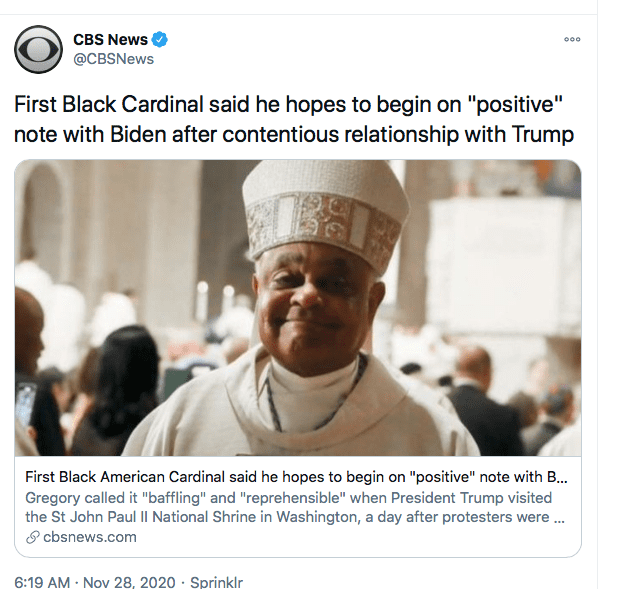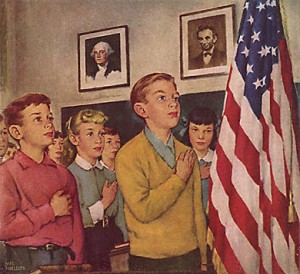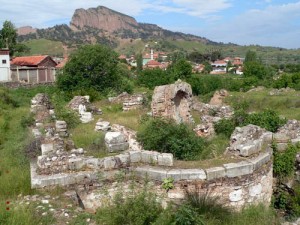There is much that those of us in 2011 can learn from Will Herberg’s important 1949 review of Paul Blanshard’s famous (or infamous) tome, American Freedom and Catholic Power (1949). Long before Christian conservatives were called “American Taliban” by secular progressives, and long before the United States had to wrestle with controversies surrounding its Muslim citizenry, American Catholic Christians were confronted by a truly vile form of bigotry and suspicion that was embraced by both elite and popular culture. Catholics were labeled by those like Blanshard, who called themselves the “true Americans,” as enemies of the very idea of America and the rights, liberties, and alliegences that this nation requires of itself and for its citizens to uphold. Appearing in the August 1949 issue of Commentary, I reproduce Herberg’s scathing review in its entirety.
The Church and American Politics [by Will Herberg]
American Freedom And Catholic Power.
by Paul Blanshard.
The Beacon Press. $3.50.
“Catholic power” is certainly a problem for American democracy. It constitutes a problem in the sense in which every potent special-interest group makes the workings of democratic government more complex. But beyond that, it raises a difficulty because the political and social aims pursued by the Catholic Church in some ways run counter to what most Americans have held to be the very foundation of their democratic way of life. The claims and pretensions of the Church to legal primacy, if not monopoly, in religion, education, and family relations, are felt to be definitely incompatible with the liberal, pluralistic foundations of American democracy. These claims have not been and are not being pushed in this country, but they have not been abandoned and they may become a matter of practical concern at any time. Equally disturbing is the Church’s tendency to confuse, or rather to equate, the spiritual interests of Christianity with the political and social, even economic, interests of the Vatican, the hierarchy, and the Church establishment. A careful study of the Catholic Church as a social power, or an analysis of its doctrines that would scrupulously avoid bias and distortion, could serve a very useful purpose. Unfortunately, Mr. Blanshard’s book, which is a much-expanded revision of the famous Nation articles, does not meet this requirement.
Not that Mr. Blanshard’s writing is not informative or well documented. It is both, and everyone can gain a great deal from a critical reading of the book. But the reading will have to be critical indeed if it is not to mislead. For Mr. Blanshard’s work, however accurate the footnotes and documentation, is permeated with anti-Catholic bias and is vitiated by a secularist-statist philosophy that, in this reviewer’s opinion at least, is far more dangerous than anything in American Catholicism to which the book calls attention.
The anti-Catholic bias, despite repeated and no doubt sincere disavowals, is pervasive and often quite offensive. What is it but vulgar anti-Catholicism to sneer “at the whole segregated system of nuns, wimples and convents” as “medieval posturing and useless mortifications” (page 287)? What is it but vulgar anti-Catholicism to ridicule the very names of Catholic religious institutions—“The Sisters of Our Lady of Charity of the Good Shepherd” is Mr. Blanshard’s prize exhibit—as reflecting “a medieval attitude of piety and feminine subordination” somehow incompatible with the robust spirit of American democracy?
Mr. Blanshard conscientiously covers the entire field of Catholic activity in the United State—the workings of the hierarchy; the position of the Church on democracy, fascism, Communism, and labor; Catholic policy on education, sex, marriage, and divorce; Catholic activities in censoring literature and films; the Catholic attitude to science and scholarship; and Catholic views on many other matters relating to American life. In every case, he finds the Church a distinct menace to American freedom. Indeed, the penultimate chapter of the book (“The Catholic Plan for America”) is a horrendous picture of what might be expected to happen to our democracy should Catholics ever come to attain majority control. A good deal of what Mr. Blanshard tells us and many of the dangers he warns against are certainly worthy of note. But our confidence in his findings and, above all, in his conclusions is greatly shaken by a certain feeling that the author is not quite candid with us, or perhaps, for that matter, with himself. There is an air of such calculated special pleading, of such arguing for effect rather than for the balanced truth, that it is really difficult to know how far one may safely follow Mr. Blanshard in his indictment of the Catholic Church. Perhaps some examples will illustrate what I mean.
He calls (page 255) the French Catholic MRP an “antisocialist political party” despite the fact that its program is well known to be modelled after that of the British Labor party. He repeats (page 299) the familiar charge that Catholics hold that “non-Catholics who deliberately reject Catholicism are headed for Hell,” when he is aware or ought to be aware that the phrase “deliberately reject” is officially understood in such a way as not to mean this at all. He goes into great detail (chapter 11) describing the Vatican’s rapprochement with the fascist regimes of Italy and Spain but has not a word to say about the same Vatican’s impressive efforts on behalf of the Jews during the Hitler terror.
Mr. Blanshard does not hesitate (page 301) to call the Catholic Church anti-Semitic on the ground that “the hierarchy teaches Catholic children (1) that they should not marry Jews; (2) that they should not go to school with Jews in a neutral atmosphere; and (3) that they must not read any Jewish literature that states the case for Jewish as against Catholic faith,” without suggesting that these same tests, particularly the first, would expose most believing Jews and very many believing Protestants to condemnation as bigoted anti-Catholics. The last point, by the way, is a good example of Mr. Blanshard’s method. He knows—indeed, he points out—that the Catholic ban on intermarriage, secular education, and reading anti-Catholic literature is not in any way directed against the Jews but is quite general in its application. He is not content, however, to criticize such a policy for what it is; he must pretend it is anti-Semitism.
But the gravest fault in the Blanshard indictment of the Catholic Church is the studied ambiguity that pervades it. Is it to the Catholic belief, grounded in supernaturalism, that he is objecting, or to what he holds to be an improper use of such belief to advance the hierarchy’s power interests’? Is it, for example, the belief in miracles and the efficacy of relics that he finds objectionable, or the exploitation of this belief for political and financial purposes? He is never quite clear; he exposes the latter but also denounces the former. In his objections to Catholic supernaturalism, he displays a rather naive faith in what he takes to be the deliverances of science. He has a perfect right under the law to hold to this strange faith, but he has no right to identify it with democracy or to condemn anything that runs counter to it as a menace to American freedom. Or has scientism, in Mr. Blanshard’s opinion, been enacted into the Constitution and made an official part of the “American way of life”?
Mr. Blanshard’s prejudices make it impossible for him to appreciate the deep concern that many religious people feel about an allegedly “neutral” school system that in fact indoctrinates the child and young person with an outlook on life in which man is held to be sufficient unto himself and God is treated as an outmoded irrelevance. This secularism, linked to an exaltation of the “social-welfare state” as an omnicompetent agency for the total control of social life, prevents Mr. Blanshard from understanding how people may seriously insist that since social, family, and educational problems are at bottom moral, they cannot be separated from one’s religious faith, and if that faith is institutionalized in that form, from one’s church.
His perfervid nationalism and statism make it hard for him to grasp how any person genuinely devoted to democracy can nevertheless contend that there is a higher law in the name of which the dictates of the state may be disallowed if these dictates are felt to come into conflict with obedience to God. Mr. Blanshard excoriates (pages 52-53) the Catholics for affirming that they would disobey a law outlawing parochial schools and compelling parents to send their children to the public schools. He thinks such an attitude outrageously undemocratic and a menace to American freedom. To me, on the contrary, this attitude seems not only intelligible but thoroughly in line with the best of democratic tradition, which has always rejected the pretensions of the state to a monopoly of social and cultural life.
I am not asserting that the Catholic answer to any of these questions is the right one. In fact, I think it is often seriously wrong. But Mr. Blanshard, by his bias, has rendered himself incapable of understanding what is really involved in the vital problems he himself raises. That is why his book, for all its information and documentation, is ultimately so unsatisfactory.
















